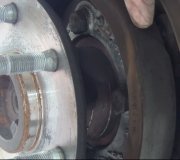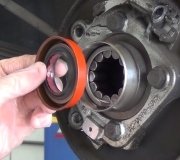Good afternoon.
Do you mean the part you push to activate the hand brake will not release or if it does, the brakes still hang up?
Roy
INITIAL ADJUSTMENT
Use this procedure when a new tension limiter is installed.
1. Make sure brake drums are cold for correct adjustment.
2. Depress the parking brake pedal fully to the last detent position.
3. Grip the Tension Limiter housing to prevent it from spinning and tighten the equalizer nut 63.50 mm ± 3.175 mm (2 1/2 in ± 1/8 in) up the rod.
4. Check to make sure cinch strap has slipped leaving less than 34.925 mm (1 3/8 in) remaining.
FIELD ADJUSTMENT
Use this procedure to correct a slack system if new tension limiter is not installed.
1. Make sure brake drums are cold for correct adjustment.
2. Apply the parking brake pedal to the fully engaged position.
3. Grip the tension limiter housing to prevent it from spinning and tighten the equalizer nut 6 full turns past its original position on the threaded rod.
4. Attach an appropriate cable tension gauge in front of the equalizer assembly on the front cable and measure cable tension. Cable tension should be 1780-2670 Nm (400-600 ft lb) with the parking brake pedal fully in the last detent position. If tension is low, repeat Steps 2 and 3.
5. Release parking brake and check for rear wheel drag.
NOTICE: The cables should be tight enough to provide full application of the rear brake shoes when the parking brake lever of foot pedal is placed in the fully applied position, yet loose enough to ensure complete release of the brake shoes when the lever is in the released position. The Tension Limiter will reset the parking brake tension any time the system is disconnected provided the distance between the bracket and the cinch strap hook is reduced during adjustment. When the cinch strap contacts the bracket, the system tension will increase significantly and over tensioning may result. If all available adjustment travel has been used, the ension limiter must be replaced.
Image (Click to make bigger)
Wednesday, April 14th, 2021 AT 10:27 AM
(Merged)





